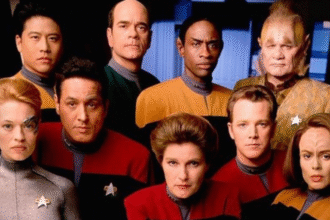J.J. Abrams’ Star Trek films transformed the franchise’s approach to storytelling across media.
- Cinematic techniques elevated Star Trek’s narrative quality in television.
- The Kelvin Timeline revitalized characters while honoring the original series.
- Serialized storytelling became a hallmark in recent Star Trek TV shows.
When J.J. Abrams directed the 2009 Star Trek reboot, it signaled a decisive shift from the show’s earlier TV roots toward a blockbuster film franchise designed for a global audience. For decades, Star Trek had been revered by sci-fi fans but viewed by some as an old-fashioned television series with a niche appeal.
Abrams changed that perception with a movie that combined rapid pacing, breathtaking effects, and emotionally charged storytelling.
Unlike the more measured episodic format of the TV shows, Abrams’ movies delivered a high-energy narrative packed with intense action scenes, thrilling space battles, and richly dramatized character moments.
One notable example is the opening sacrifice of George Kirk, depicted as a heroic moment setting an emotional tone and instantly hooking viewers. The cinematic style embraced a modern aesthetic of dynamic camera movements and lighting techniques, including Abrams’ signature lens flares and visually stylized sets.
These innovations broadened Star Trek’s audience, drawing in viewers who may not have previously engaged with the franchise.
The influence of this cinematic approach quickly bled into Star Trek television. With the rise of streaming platforms and higher budgets, newer Star Trek shows began adopting more cinematic production techniques.
Also Read: EVNNE’s Future Secured: Multiple Members Renew Contracts with Jellyfish Entertainment
This created a seamless experience where TV series like Star Trek: Discovery and Star Trek: Strange New Worlds reflected the sleek visuals and storytelling sophistication fans discovered in the films.
The atmosphere shifted from the traditional television feeling to something that rivaled major feature films in quality and scope, elevating Star Trek’s profile across media.
The Kelvin Timeline: A Bold Change to Star Trek Continuity
One of Abrams’ most transformative contributions was introducing the Kelvin Timeline, a parallel universe plotline that allowed him to reboot the Star Trek saga without discarding its legacy.
By setting this timeline apart from the original, Abrams preserved the cherished characters and story history of the classic series while opening creative freedom to invent new arcs and characters without upsetting existing continuity.
The Kelvin Timeline begins with a catastrophic event, the destruction of the starship Kelvin, which diverged from established canon and led to altered destinies for beloved figures such as Captain Kirk, Spock, and others.


This alternate timeline allowed Abrams to introduce modern dilemmas and a fresh emotional dimension without rewriting the entire Star Trek saga. It essentially refreshed the brand while honoring its past.
This move not only impacted the movies but also shaped the narrative DNA of Star Trek’s latest television shows. Series including Star Trek: Discovery and Picard have interwoven aspects of the Kelvin Timeline into their storytelling, blending classic Star Trek ideals with innovative plot devices born in Abrams’ films.
The coexistence of timelines encouraged writers and producers to explore diverse stories without the constraints imposed by decades of original series lore. Visual references, costumes, and technology often nod back to the films, creating a consistent universe across screen formats.
The Kelvin Timeline has helped broaden Star Trek’s appeal beyond nostalgic fans to a younger, more diverse audience eager for fresh narratives and inclusive representation. The freedom it grants storytellers continues to be a cornerstone of how Star Trek lives and evolves on television.
Revitalizing Characters and Parent-Child Dynamics
Abrams’ films brought new emotional depth to Star Trek’s iconic characters, a change that resonated through television adaptations. Captain James T. Kirk was portrayed as a more human, nuanced figure wrestling with expectations and personal loss, offering audiences a new connection beyond his traditional heroic bravado.
This portrayal has inspired TV shows to explore these characters’ inner lives with greater focus, moving past archetypes toward psychological complexity.
The film also emphasized family relationships more overtly, such as the mentor-mentee bond between Captain Pike and Jim Kirk. This dynamic added layers of emotional resonance that TV series have continued to examine, revealing vulnerabilities, legacy, and motivation through familial ties.
Similarly, Spock’s dual heritage and struggles were given renewed importance, influencing portrayals in subsequent series both thematically and narratively.
Female characters and diversity also saw renewed attention in the movies, with Abrams elevating Lieutenant Uhura and opening doors to new roles for women and broader ethnic representation.
This has translated into the TV shows consciously incorporating diverse casts and stories that mirror contemporary societal values while still embracing Star Trek’s original mission of portraying a hopeful future of inclusivity.
Technological Upgrades That Crossed Over to TV
Star Trek’s technology has always been a hallmark, but Abrams’ films updated many flagship concepts with a new visual style and practical applications, rebooting how audiences perceive futuristic tech in the franchise.
The transporter, for example, was reimagined with advanced visual effects that emphasized seamless, believable teleportation, which TV series then adopted in their own production designs.
Similarly, starship designs in the Abrams era incorporated sleeker profiles and intricate detailing that later appeared in television series, reflecting the idea that TV Star Trek was no longer separate from blockbuster aesthetics.
These technological updates aligned with advancements in real-world filmmaking techniques and expectations for sci-fi realism and spectacle.
By blending practical effects, CGI, and smart design, Abrams set a standard for technical storytelling that TV’s Star Trek shows have embraced, marrying serialized narratives with blockbuster visuals.
This blend has helped sustain audience immersion and broaden franchise appeal even as TV storytelling expanded into complex arcs and themes.
Storytelling Shifts: From Episodic to Serialized Narratives
Traditional Star Trek shows were often episodic, with self-contained stories wrapped in around 45 minutes to an hour. Abrams’ movies, however, borrowed more from blockbuster film storytelling with ongoing arcs, character development spanning across films, and high stakes that unfolded over several hours of cinematic runtime.
This shift toward serialized storytelling has influenced Star Trek television, where later seasons of shows such as Discovery and Picard involve long, intricate plots about politics, identity, and survival.
As seen in contemporary TV globally, audiences now expect ongoing development and multi-episode arcs, lending more weight and emotional investment to characters’ journeys.
By demonstrating the power of serialized arcs, Abrams’ work also encouraged producers of the Star Trek TV series to take risks in terms of narrative ambition and production quality, aligning the franchise with larger trends in premium television and streaming content.
Impact on Franchise Business and Fan Culture
Abrams’ reinvention of Star Trek made a notable impact beyond storytelling and visuals by revitalizing the franchise’s business prospects.
His successful box office returns gave the franchise a commercial boost that allowed more investment in TV spin-offs and merchandise, creating a cycle that sustained Star Trek’s place in pop culture conversation.
However, not all fans embraced the changes warmly. Abrams’ reboot sparked debates about “canon” and Star Trek’s core ethos, particularly among long-term viewers who worried some of the classic elements and philosophies were diluted or overshadowed by blockbuster spectacle.
Fan conventions, online communities, and critics remain divided, but many acknowledge that Abrams’ movies brought unprecedented energy and visibility to the franchise that helped it reach new generations and global markets.
This tension between legacy and innovation continues to shape how Star Trek moves forward across different media platforms. The ways J.J. Abrams changed Star Trek through his movies resonate strongly in the television shows that followed.
From visual style and timelines to character development and storytelling techniques, his influence is woven into today’s Star Trek universe, proving that even a decades-old franchise can successfully reinvent itself to match the expectations of contemporary viewers while still honoring familiar tales.
Also Read: Little Amélie Or The Character Of Rain: A Wondrous Coming Of Age Tale That Transcends Space and Time
People Also Ask
- What was the impact of J.J. Abrams’ 2009 Star Trek reboot on the franchise?
-
Abrams’ reboot shifted Star Trek from a niche television series to a blockbuster film franchise, attracting a broader global audience.
- What is the Kelvin Timeline introduced by Abrams?
-
The Kelvin Timeline is a parallel universe plotline that allows for a reboot of the Star Trek saga while preserving its legacy and characters.
- How did Abrams’ films influence character development in Star Trek television shows?
-
Abrams’ films added emotional depth to characters, encouraging TV shows to explore their inner lives and familial relationships more intricately.
- What technological updates did Abrams bring to Star Trek?
-
Abrams updated flagship concepts like the transporter and starship designs, which were later adopted by television series, enhancing visual storytelling.
- How did storytelling change in Star Trek due to Abrams’ influence?
-
Abrams’ films shifted the franchise from episodic storytelling to serialized narratives, impacting later TV shows with ongoing character arcs and complex plots.
- What was the reaction of fans to Abrams’ changes to Star Trek?
-
While some fans embraced the revitalization of the franchise, others expressed concerns about changes to canon and the dilution of classic elements.








